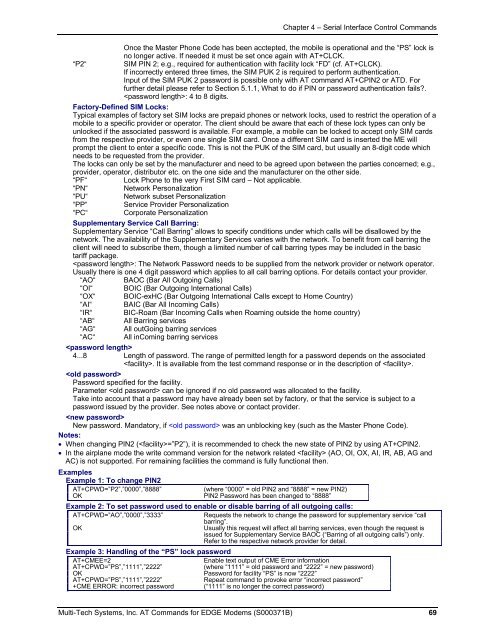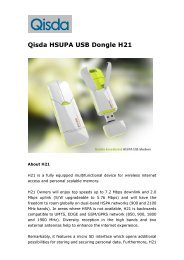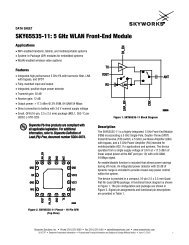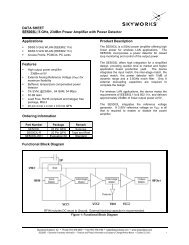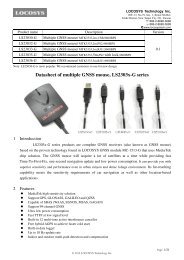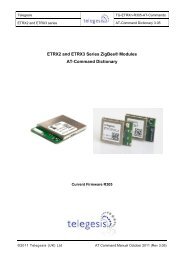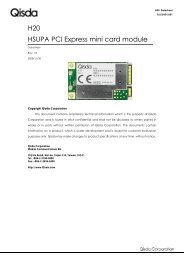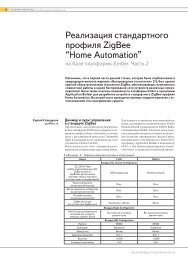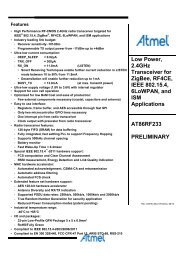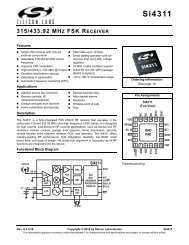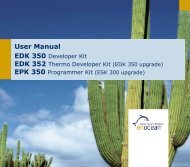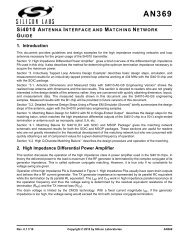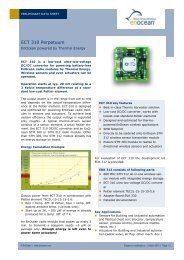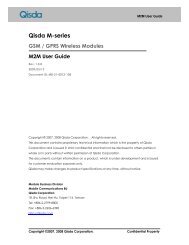AT Command Reference Guide for EDGE Wireless ... - wless.ru
AT Command Reference Guide for EDGE Wireless ... - wless.ru
AT Command Reference Guide for EDGE Wireless ... - wless.ru
You also want an ePaper? Increase the reach of your titles
YUMPU automatically turns print PDFs into web optimized ePapers that Google loves.
Chapter 4 – Serial Interface Control <strong>Command</strong>s<br />
Once the Master Phone Code has been acctepted, the mobile is operational and the “PS” lock is<br />
no longer active. If needed it must be set once again with <strong>AT</strong>+CLCK.<br />
“P2“<br />
SIM PIN 2; e.g., required <strong>for</strong> authentication with facility lock “FD” (cf. <strong>AT</strong>+CLCK).<br />
If incorrectly entered three times, the SIM PUK 2 is required to per<strong>for</strong>m authentication.<br />
Input of the SIM PUK 2 password is possible only with <strong>AT</strong> command <strong>AT</strong>+CPIN2 or <strong>AT</strong>D. For<br />
further detail please refer to Section 5.1.1, What to do if PIN or password authentication fails.<br />
: 4 to 8 digits.<br />
Factory-Defined SIM Locks:<br />
Typical examples of factory set SIM locks are prepaid phones or network locks, used to restrict the operation of a<br />
mobile to a specific provider or operator. The client should be aware that each of these lock types can only be<br />
unlocked if the associated password is available. For example, a mobile can be locked to accept only SIM cards<br />
from the respective provider, or even one single SIM card. Once a different SIM card is inserted the ME will<br />
prompt the client to enter a specific code. This is not the PUK of the SIM card, but usually an 8-digit code which<br />
needs to be requested from the provider.<br />
The locks can only be set by the manufacturer and need to be agreed upon between the parties concerned; e.g.,<br />
provider, operator, distributor etc. on the one side and the manufacturer on the other side.<br />
“PF“<br />
Lock Phone to the very First SIM card – Not applicable.<br />
“PN“ Network Personalization<br />
“PU“ Network subset Personalization<br />
“PP“ Service Provider Personalization<br />
“PC“ Corporate Personalization<br />
Supplementary Service Call Barring:<br />
Supplementary Service “Call Barring” allows to specify conditions under which calls will be disallowed by the<br />
network. The availability of the Supplementary Services varies with the network. To benefit from call barring the<br />
client will need to subscribe them, though a limited number of call barring types may be included in the basic<br />
tariff package.<br />
: The Network Password needs to be supplied from the network provider or network operator.<br />
Usually there is one 4 digit password which applies to all call barring options. For details contact your provider.<br />
“AO“ BAOC (Bar All Outgoing Calls)<br />
“OI“ BOIC (Bar Outgoing International Calls)<br />
“OX“ BOIC-exHC (Bar Outgoing International Calls except to Home Country)<br />
“AI“ BAIC (Bar All Incoming Calls)<br />
“IR“ BIC-Roam (Bar Incoming Calls when Roaming outside the home country)<br />
“AB“ All Barring services<br />
“AG“ All outGoing barring services<br />
“AC“ All inComing barring services<br />
<br />
4...8 Length of password. The range of permitted length <strong>for</strong> a password depends on the associated<br />
. It is available from the test command response or in the description of .<br />
<br />
Password specified <strong>for</strong> the facility.<br />
Parameter can be ignored if no old password was allocated to the facility.<br />
Take into account that a password may have already been set by factory, or that the service is subject to a<br />
password issued by the provider. See notes above or contact provider.<br />
<br />
New password. Mandatory, if was an unblocking key (such as the Master Phone Code).<br />
Notes:<br />
• When changing PIN2 (=”P2”), it is recommended to check the new state of PIN2 by using <strong>AT</strong>+CPIN2.<br />
• In the airplane mode the write command version <strong>for</strong> the network related (AO, OI, OX, AI, IR, AB, AG and<br />
AC) is not supported. For remaining facilities the command is fully functional then.<br />
Examples<br />
Example 1: To change PIN2<br />
<strong>AT</strong>+CPWD=”P2”,”0000”,”8888”<br />
(where “0000” = old PIN2 and “8888” = new PIN2)<br />
OK PIN2 Password has been changed to “8888”<br />
Example 2: To set password used to enable or disable barring of all outgoing calls:<br />
<strong>AT</strong>+CPWD=”AO”,”0000”,”3333”<br />
Requests the network to change the password <strong>for</strong> supplementary service “call<br />
barring”.<br />
OK<br />
Usually this request will affect all barring services, even though the request is<br />
issued <strong>for</strong> Supplementary Service BAOC (“Barring of all outgoing calls”) only.<br />
Refer to the respective network provider <strong>for</strong> detail.<br />
Example 3: Handling of the “PS” lock password<br />
<strong>AT</strong>+CMEE=2<br />
Enable text output of CME Error in<strong>for</strong>mation<br />
<strong>AT</strong>+CPWD=”PS”,”1111”,”2222”<br />
(where “1111” = old password and “2222” = new password)<br />
OK Password <strong>for</strong> facility “PS” is now “2222”<br />
<strong>AT</strong>+CPWD=”PS”,”1111”,”2222”<br />
Repeat command to provoke error “incorrect password”<br />
+CME ERROR: incorrect password (“1111” is no longer the correct password)<br />
Multi-Tech Systems, Inc. <strong>AT</strong> <strong>Command</strong>s <strong>for</strong> <strong>EDGE</strong> Modems (S000371B) 69


